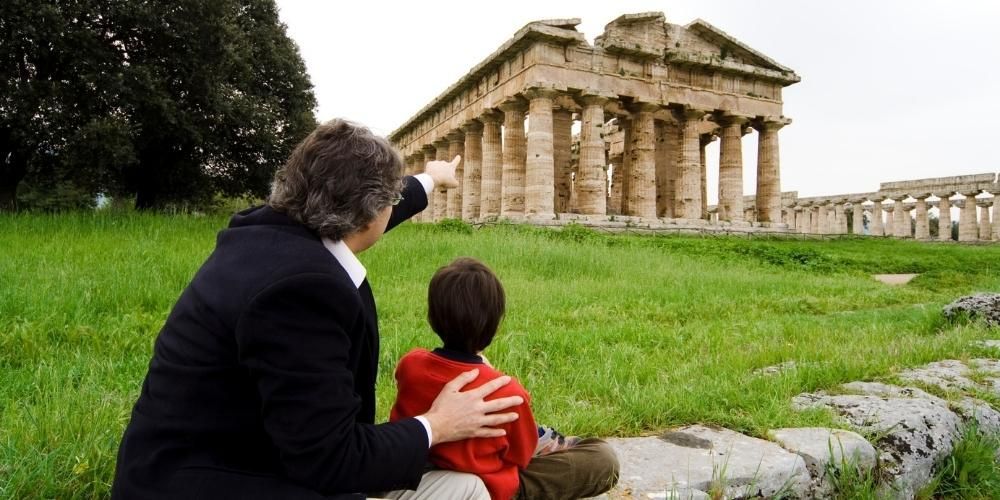There are many ways to celebrate Father's Day in Italy. In fact (almost) every region has its own typical cake for this day. Let's find them out.
Every country in the world has its own Father's Day. In Italy, on 19 March, people thank their fathers for the gift of life and what they do for their children day after day. All children recite a poem or prepare greetings cards with a thought for their father. Father's Day is the opportunity to thank fathers for their sacrifices.
For some years now, Father's Day in Italy has not just been about giving a tie or a pair of slippers. Dads are increasingly active in family life and in bringing up children. So the party is the perfect opportunity to indulge dads and have the experience to remember together. A trip, a hike, an outing or a pick-nick in the fresh air are just a few suggestions for spending this day. And why not, a sweet tour in the principal Italian regions, tasting the traditional sweets prepared only on the occasion of Father's Day in Italy.

"Children need witnesses who tell them not what the meaning of existence is, but who show them through their lives that existence can have meaning".
The History of Father's Day in Italy

Father's Day in Italy has very ancient origins. It originated with the celebration of St Joseph, husband of the Blessed Virgin Mary and symbol of dedication and humility. His cult spread in the East from the Middle Ages and in the West from the 14th century. Many religious orders began to celebrate St Joseph on 19 March because it was believed to be the day of his death. He became the patron saint of the universal Church. In 1889 Pope Leo XIII made him the patron saint of family fathers and workers. From that year, children began to make small presents for their fathers.
St Joseph is also the protector of orphans, unmarried girls and the unfortunate. 19 March, therefore, becomes an occasion to invite poor and needy people to lunch. Since the celebration of St Joseph's Day coincides with the end of winter, pagan cults overlap with religious cults. In some villages, it is customary to perform propitiatory rites in which harvest residues are burnt in the fields. Large bonfires are lit in the squares, to be jumped over, as a symbol of the transition to a new season, while local old women spin and sing songs to St Joseph.
Cakes for Father's Day in Italy

Every year in Italy, for Father's Day, are prepared tastiest and most delicate cake: "Zeppole di San Giuseppe". This incredible sweet makes perfect this day. It is a cake whose recipe varies from region to region and is an excellent cream or jam-based sweet, contained in a soft Choux pastry. It is a typical Italian dessert that originates from an ancient tradition of Roman times. It is said that after escaping from Egypt, St Joseph, to protect his family and raise Jesus, began selling pancakes similar to those made today.
Another legend has it that the birth of zeppole is linked to the "Liberalia", festivals in honour of the gods of wine and grain, celebrated in ancient Rome. To glorify the god Bacchus and his tutor Silenus was offered wine in large quantities. To honour the God of Wheat were fried wheat fritters. Are you ready to delight your taste buds for Father's Day in Italy? Let's celebrate dads on a "Zeppole tour" in some of Italy's most beautiful regions.
5. Desserts for Father's day in Italy in Tuscany: the Rice Fritters

We start our tour in Tuscany, where Father is better known as "Babbo". Do you know where this name comes from? According to studies conducted by the Accademia Della Crusca, the word "Babbo" originated in Italy. It is one of the first words spoken by children and has a strong emotional meaning. With the word "Babbo", children indicate their daddy, differentiating him from the others and expressing their special bond.
All this sweetness is contained in what is called "Frittelle di San Giuseppe". In Tuscany, on 19 March, Father's Day, you can enjoy delicious little cakes made with rice and fried in plenty of oil. They are excellent eaten hot or warm, accompanied by a good vin santo. The "Frittelle di San Giuseppe" are not only simple and delicious Tuscan's dessert, but they are also a treasure of immense historical value. With every bite, you can go back in time, when on 19 March, in the 1960s, in Siena, in Piazza del Campo, many "Frittellai" set up their "Bancarella" and prepared rice fritters. It was a poor sweet but much loved by young and old alike.
On that day, a sweet aroma flooded the streets and drew everyone to the square to celebrate their father. They are small fried balls filled with rice, milk and orange peel that have accompanied the childhood of the Tuscans for generations. A tradition so strong that the proverb 'St Joseph's Day is not made without fritters' has become widespread.
Treat yourself to a marvelous trip to discover the masterpieces of Pisa, San Gimignano, and Siena with the ticket by Visit Italy.
Visit Pisa, San Gimignano e Siena with a guided tour❯4. Emilia Romagna: the Raviole

A sweet Father's Day in Italy also in Emilia Romagna. How? With "Raviole Bolognesi" di San Giuseppe. They are a delicious and traditional dessert, of poor origins. It was prepared as a symbol of a good omen to start the spring sowing season in the Emilian countryside. This meant a return to work and earnings. To celebrate, "Raviole" were prepared and left hanging from hedges and windows on the first floor, available to passers-by.
The "Raviole" have a half-moon shape, from which they take their name because they resemble the shape of ravioli. They are a simple dessert, made of soft shortcrust pastry and filled with mostarda bolognese. This is a sour jam with quince, apples, plums and orange peel. On Father's Day, it is a tradition in Bologna to enjoy "raviole tocciate", dipped, in a glass of milk at breakfast or in a glass of excellent red wine at lunch. You will be so delighted that one "raviola" will pull the other you won't be able to stop!
You could explore the charming historical centre of Bologna, embellished by splendid ancient monuments, with the ticket reserved for you by Visit Italy.
Discover the Bologna guided tour❯3. Sicily: the Sfincia of Saint Joseph
How could you not go to Sicily on Father's Day to taste a very work of art. In Sicily, it is well known that sweets are a riot of flavours, colours and scents originating from deep-rooted stories. In Sicily, on Father's Day, the tastiest cake is prepared, with an ancient history that takes us back in time: the Sfincia di San Giuseppe. The name "Sfincia" derives from the Arabic "isfanǧ", meaning sponge, because it is a soft dessert, with an irregular shape like a sponge.
The current form is the work of the "Poor Clare Nuns of the Monastery of the Stigmata of San Francesco" in Palermo. The nuns dedicated this cake to St Joseph, the saint of the humble, and then passed it on to the confectioners of Palermo, who made this small masterpiece of sweetness famous. The "Sfincia", because of its historicity, has been officially listed as a Traditional Food Product. It is becoming part of Sicily's cultural and gastronomic heritage. Let yourself be enchanted on this day full of sweetness by a soft fried puff covered with ricotta cheese and decorated with cherries and orange peel or with chocolate drops and pistachio grains.
2. Lazio: the Bignè of Saint Joseph

Father's Day in Italy is an excellent occasion to visit the Eternal City. In Lazio, too, it is a day to celebrate by sharing the pleasure of savouring the typical father's cake, the Bignè di San Giuseppe. The "Bignè", filled with cream, fried or baked, is an invitation to Roman conviviality on 19 March. This tradition started when the Confraternity of San Giuseppe Dei Falegnami organised large celebrations in honour of the Saint.
During the traditional celebrations, street vendors sold fritters and freshly fried cream puffs. The Romans love this festival so much that they call St Joseph the "Frittellaro Saint". This little cream puff is a delight for the palate. It is a round-shaped Choux pastry cake filled with Italian-style Chantilly cream. The magic touch is the icing sugar coating that inevitably stays between your fingers when you eat it. They are an explosion of goodness.
Would you like to admire Rome's spectacular monuments and magnificent attractions? Benefit from the exclusive advantages reserved for Roma Tourist Card holders.
Discover Roma Tourist Card❯1. Campania: the Zeppola of Saint Joseph

The home of the Zeppola di San Giuseppe is Campania. Naples is the heart of the celebrations in honour of St Joseph and the father. The origins of this delicious dessert have their roots in the Neapolitan land. The first recipe dates back to 1837, found in the treatise on Theoretical-Practical Cooking by the gastronome Ippolito Cavalcanti, Duke of Buonvicino. This was the birthplace of the "Zeppolaro di Strada", who, until a few years ago, used to sell zeppole freshly fried in hot oil in the alleys of Naples.
This famous dessert is a circular form of Choux pastry. It has a hole in the middle, covered in custard and with a black cherry in syrup in the centre. To finish, a light dusting of icing sugar. But who invented the shape of the zeppole? Although not entirely sure, it seems that the shape of this cake came from the nuns of Splendour and the Cross in Lucca or the nuns of San Basilio at the Monastery of San Gregorio Armeno in the 1700s. What is certain is that the best way to celebrate with your dad is to enjoy this wonder of Neapolitan tradition, walking along the seafront and admiring the splendour of the city.




